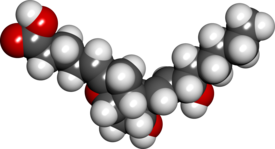Flolan
 |
|
 |
|
| Clinical data | |
|---|---|
| AHFS/Drugs.com | Monograph |
| ATC code | |
| Identifiers | |
|
|
| CAS Number | |
| PubChem CID | |
| IUPHAR/BPS | |
| DrugBank | |
| ChemSpider | |
| ChEMBL | |
| Chemical and physical data | |
| Formula | C20H32O5 |
| Molar mass | 352.465 g/mol |
| 3D model (Jmol) | |
|
|
|
|
|
|
|
Prostacyclin (also called prostaglandin I2 or PGI2) is a prostaglandin member of the eicosanoid family of lipid molecules. It inhibits platelet activation and is also an effective vasodilator.
When used as a drug, it is also known as epoprostenol. The terms are sometimes used interchangeably.
During the 1960s, a U.K. research team, headed by Professor John Vane, began to explore the role of prostaglandins in anaphylaxis and respiratory diseases. Working with a team from the Royal College of Surgeons, Sir John discovered that aspirin and other oral anti-inflammatory drugs work by inhibiting the synthesis of prostaglandins. This critical finding opened the door to a broader understanding of the role of prostaglandins in the body.
Sir John and a team from the Wellcome Foundation, had identified a lipid mediator they called “PG-X,” which inhibits platelet aggregation. PG-X, which later would become known as prostacyclin, is 30 times more potent than any other then-known anti-aggregatory agent.
By 1976, John Vane and fellow researchers Salvador Moncada, Ryszard Gryglewski and Stuart Bunting published the first paper on prostacyclin, in the scientific journal Nature. The collaboration produced a synthesized molecule, which was given the name epoprostenol. But, as with native prostacyclin, the structure of the epoprostenol molecule proved to be unstable in solution, prone to rapid degradation. This presented a challenge for both in vitro experiments and clinical applications.
To overcome this challenge, the research team that discovered prostacyclin was determined to continue the research in an attempt to build upon the success they had seen with the prototype molecule. The research team synthesized nearly 1,000 analogues.
Prostacyclin is produced in endothelial cells, which line the walls of arteries and veins, from prostaglandin H2 (PGH2) by the action of the enzyme prostacyclin synthase. Although prostacyclin is considered an independent mediator, it is called PGI2 (prostaglandin I2) in eicosanoid nomenclature, and is a member of the prostanoids (together with the prostaglandins and thromboxane).
...
Wikipedia
